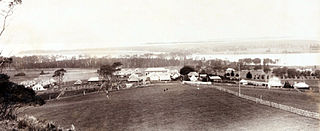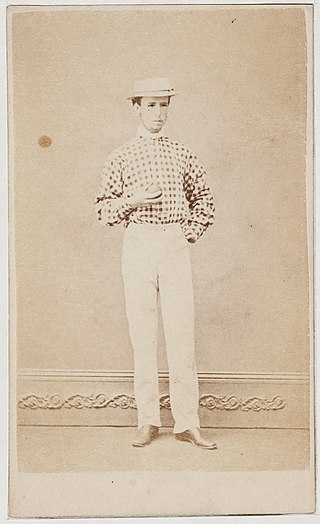Related Research Articles

The Coolangatta Estate at Coolangatta, near Shoalhaven Heads was established in 1822 by Alexander Berry on the South Coast of New South Wales, Australia. Coolangatta Estate is located on the northern bank of the Shoalhaven River, in the foothills of Coolangatta Mountain. The word 'Coolangatta' is from an aboriginal word which means either splendid view or good lookout. The estate today is in a picturesque setting overlooking the ocean and surrounded by vineyards.

Leslie Oswald Sheridan Poidevin was an Australian tennis player and first-class cricketer who played for New South Wales and Lancashire.
Charlotte Badger was a former convict who was on board the Venus during a mutiny in Tasmania in 1806. Taken to New Zealand, she was rescued by Captain Turnbull of the Indispensible, and eventually she returned to Sydney. In the intervening centuries, a number of writers have contributed to the fiction that she took an active role in the mutiny and she became known – erroneously – as Australia's first female pirate.

Francis Edmund Town Fowler was a British-born author and journalist who later played a significant role in the early development of Australia's literary culture. He is best known for his book Southern Lights and Shadows, and for founding and editing Australia's first literary journal, The Month.
The Goulburn Chronicle and Southern Advertiser was a weekly English language newspaper published in Goulburn, New South Wales from 1855–1864.

Thomas Iceton was an Australian cricketer and solicitor. He graduated with an M.A. from Sydney University where he also distinguished himself as a cricketer. Iceton played one first-class match for New South Wales in 1877-78.
The Orielton Homestead is an estate in the Macarthur Region of Sydney, New South Wales, Australia. It is located on the grounds of Harrington Grove, which is part of the Harrington Park estate.

Milton Kent was a pioneer of industrial and aerial photography, a prize-winning airman and a champion sculler. Initially, Kent worked as a sports photographer but by the 1920s he had embraced aerial photography using a specially crafted oblique camera. Over the next 50 years, Kent used his camera to capture the opening of new blocks of land across Sydney, the construction of the harbour bridge and many other events up until his death in 1965.
Photo-crayotypes were an artistic process used for the hand-colouring of photographs by the application of crayons and pigments over a photographic impression.
Kangiara is a locality, in the Yass Valley Council local government area, within the Southern Tablelands of New South Wales, Australia. There was once a mining village of the same name.
The SS Trebartha was a 4,597 GRT cargo carrying steamship built in 1920 by John Readhead & Sons Ltd of South Shields for the Hain Steamship Company. She was attacked by German aircraft on the 11th November and sank on the 12th November 1940.
Margaret Senior OAM was an English/Australian Natural History, Wildlife and Children's Book Illustrator. She contributed to a significant portion of early Illustration of Australia's exploration of rich natural Fauna and Flora. Her works are held in the collections of New South Wales Department of Primary Industries Orange Scientific Collections Unit and The University of Newcastle Special Collections Archives. She created numerous Illustrated posters and Botanical Plates for the NSW National Parks and Wildlife Service. Her illustrations were heavily used by parks and Wildlife, including Bushfire prevention posters.

George Barron Goodman, also known as George Baron Goodman, was a practitioner of the Daguerreotype in the 1840s and Australia’s first professional photographer. He was also one of the first to hold the rights to use Daguerre's process in the British Colonies.
The Democrat, or Under the Southern Cross is a 1891 Australian stage play by Edmund Duggan about the Eureka Rebellion. It is the first known stage play on this conflict. It was revived in 1897 under the title Eureka Stockade.
Helen Heney was an Australian author. She was educated at the University of Sydney and lived in Poland from 1929 to 1935. She wrote fiction, social commentary and translation.
The Shades Will Not Vanish is a 1952 Australian novel by Helen Fowler. It was her first novel.
Only a Fool, or Chico the Jester is a 1880 Australian play by F. R. C. Hopkins. It was produced by Alfred Dampier as a vehicle for Dampier and his daughters.
£SD, or One of the Crowd is a 1882 Australian play by F. R. C. Hopkins.
The Life and Death of Captain Cook is a 1888 Australian play by John Perry presented by Alfred Dampier to celebrate Australia's centenary.
To the West is a 1896 Australian stage play by Alfred Dampier and Kenneth Mackay, a Member of Parliament. It was Mackay's first play. The script was based on an earlier work of Mackay's, The Yellow Wave.
References
- ↑ "THE ROYAL STANDARD THEATRE." The Sydney Morning Herald (NSW : 1842 - 1954) 3 September 1887: 13. Web. 7 May 2024 <http://nla.gov.au/nla.news-article13658594>.
- ↑ 1917 'THE PLAYHOUSE', The Mirror (Sydney, NSW : 1917 - 1919), 29 September, p. 10., viewed 07 May 2024, http://nla.gov.au/nla.news-article116969139
- ↑ 1887 'AMUSEMENTS.', The Daily Telegraph (Sydney, NSW : 1883 - 1930), 3 September, p. 6., viewed 07 May 2024, http://nla.gov.au/nla.news-article236763002
- ↑ "90 Years of Australian Drama; The Hits and the Flops.", Everyones., Sydney: Everyones Ltd, 10 December 1930, nla.obj-564400612, retrieved 7 May 2024– via Trove
- ↑ Rees, Leslie (1953). Towards an Australian Drama. p. 25.
- ↑ 1887 'THE ROYAL STANDARD THEATRE.—" THE WRECK OF THE DUNBAR."', The Sydney Morning Herald (NSW : 1842 - 1954), 5 September, p. 5., viewed 07 May 2024, http://nla.gov.au/nla.news-article13648048
- ↑ 1887 'Amusements.', Evening News (Sydney, NSW : 1869 - 1931), 5 September, p. 8., viewed 07 May 2024, http://nla.gov.au/nla.news-article108008206